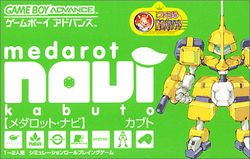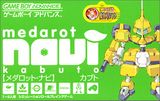Medarot Navi: Difference between revisions
m (Added the crappy infobox template. Don't worry, I'll fix it soon... D;) |
mNo edit summary |
||
| (5 intermediate revisions by 2 users not shown) | |||
| Line 3: | Line 3: | ||
| name-j = メダロット・ナビ | | name-j = メダロット・ナビ | ||
| name-r = Medarotto Nabi | | name-r = Medarotto Nabi | ||
| image = | | image = Medarot Navi Box Art.jpg | ||
| genre = Strategy RPG | | genre = Strategy RPG | ||
| platform = Game Boy Advance | | platform = Game Boy Advance | ||
| Line 13: | Line 13: | ||
'''Medarot Navi''' is the first game in the Medarot series released for the Game Boy Advance system. It was released in two versions: Kabuto Version (represented by [[Granbeetle]]) and Kuwagata Version (represented by [[Sonic Stag]]). | '''Medarot Navi''' is the first game in the Medarot series released for the Game Boy Advance system. It was released in two versions: Kabuto Version (represented by [[Granbeetle]]) and Kuwagata Version (represented by [[Sonic Stag]]). | ||
This game features a different protagonist from previous entries in the series: Kasumi | This game features a different protagonist from previous entries in the series: Kasumi Asano, a bespectacled boy who discovers an alien Medarot, [[Mistral]], underneath the auditorium of an abandoned school. A field trip to the [[Cluster]] space station goes awry with the "exile" of the class to the various modules and the reveal of the Space Robos! | ||
Unlike the other entries in the series with their | Unlike the other entries in the series with their charge/cooldown "relay race" cycles, Medarot Navi features a tiled 9x9 map that more closely resembles Fire Emblem and an initiative system similar to Final Fantasy Tactics. Movement and Part Actions are carried out using "Action Points" that are distributed at the beginning of the turn and expended when a Medarot acts. | ||
== Battle Basics == | == Battle Basics == | ||
:''Main article: [[Battle system (Medarot Navi)]]'' | |||
Medarot Navi allows each side in a battle to command up to five Medarots per battle (up from three in traditional games). Kasumi himself will rarely command more than a single Medarot, however, instead relying upon his schoolmates and other acquaintances to back him up with their own signature Medarots. This roster of allies will grow as the game progresses, giving the player many options in a given battle without having to "grind" for parts. | |||
Medarot Navi allows each side in a battle to command up to five Medarots per battle (up from three in traditional games). Kasumi himself will rarely command more than a single Medarot, however, instead relying upon his schoolmates and other acquaintances to back him up with their own signature Medarots. This roster of allies will grow as the game progresses, giving the player many options in a given battle without having to "grind" for | |||
At the start of each turn, all Medarots on the field receive AP (Action Points). When a unit's turn arrives they must decide on an Action; all Parts, Drives and other actions have unique AP costs. The Medarot can then spend its remaining AP to Move into position before acting and ending its turn; any AP left over will be converted into [[Medaforce|MF]] next turn. Robottles end when either one side's Leader ceases function or when the Turn Limit is exceeded. | At the start of each turn, all Medarots on the field receive AP (Action Points). When a unit's turn arrives they must decide on an Action; all Parts, Drives and other actions have unique AP costs. The Medarot can then spend its remaining AP to Move into position before acting and ending its turn; any AP left over will be converted into [[Medaforce|MF]] next turn. Robottles end when either one side's Leader ceases function or when the Turn Limit is exceeded. | ||
If the player wins a Robottle, Kasumi will receive one random | If the player wins a Robottle, Kasumi will receive one random part from the enemy team; enough victories will fill out the Parts List and allow the player to build up Kasumi's Tinpets, allowing for the use of alternative Leaders or customized allies (the latter controlled by the unit's Medal via a pre-programmed [[Rotation]]). Completion of the Parts List relies on frequent battling and trading parts with the opposite version of the game. | ||
== Cluster, Module Security and Parts Research == | == Cluster, Module Security and Parts Research == | ||
| Line 31: | Line 30: | ||
The Space Robos are in command of many of Cluster's Modules at the start of the game. While the player is free to liberate any Module they can reach, they must station classmates as Security to prevent them from being retaken. Each Module has a dominant battlefield terrain and, by assigning classmates with compatible Medarots, it will be easier for Kasumi to gain ground in his ascent. | The Space Robos are in command of many of Cluster's Modules at the start of the game. While the player is free to liberate any Module they can reach, they must station classmates as Security to prevent them from being retaken. Each Module has a dominant battlefield terrain and, by assigning classmates with compatible Medarots, it will be easier for Kasumi to gain ground in his ascent. | ||
Some Modules contain Parts Research centers, each one containing data for a certain Medarot. Posting compatible allies as Security will allow them to develop these Medarots; when research reaches 100% Kasumi will be given a full set of the | Some Modules contain Parts Research centers, each one containing data for a certain Medarot. Posting compatible allies as Security will allow them to develop these Medarots; when research reaches 100% Kasumi will be given a full set of the parts in question. Multiple instances of a given Medarot can be produced (and ''must'' be to fill out the parts list), but progress will return to 0% if the Module is retaken. | ||
== Continuity and Placement == | |||
According to the official Medarot Navi timeline, the game is set in 2024, two years after Medarot 2, 3, and 4. | |||
== Box Art == | |||
<gallery widths=160 heights=160> | |||
File:Medarot Navi Box Art.jpg|Kabuto version | |||
File:Medarot Navi Kuwagata Box.jpg|Kuwagata version | |||
</gallery> | |||
== See Also == | == See Also == | ||
*[[ | * [[Characters in Medarot Navi]] | ||
*[[ | * [[Medarot Navi (manga)]] | ||
{{game list links|Medarot Navi|Medaforces}} | |||
{{Navbox-Game}} | |||
Latest revision as of 14:22, 23 April 2024
| Medarot Navi メダロット・ナビ | |

| |
| Genre | Strategy RPG |
|---|---|
| Platform | Game Boy Advance |
| Developer | Natsume |
| Publisher | Imagineer |
| Release Date | September 7, 2001 |
Medarot Navi is the first game in the Medarot series released for the Game Boy Advance system. It was released in two versions: Kabuto Version (represented by Granbeetle) and Kuwagata Version (represented by Sonic Stag).
This game features a different protagonist from previous entries in the series: Kasumi Asano, a bespectacled boy who discovers an alien Medarot, Mistral, underneath the auditorium of an abandoned school. A field trip to the Cluster space station goes awry with the "exile" of the class to the various modules and the reveal of the Space Robos!
Unlike the other entries in the series with their charge/cooldown "relay race" cycles, Medarot Navi features a tiled 9x9 map that more closely resembles Fire Emblem and an initiative system similar to Final Fantasy Tactics. Movement and Part Actions are carried out using "Action Points" that are distributed at the beginning of the turn and expended when a Medarot acts.
Battle Basics[edit]
- Main article: Battle system (Medarot Navi)
Medarot Navi allows each side in a battle to command up to five Medarots per battle (up from three in traditional games). Kasumi himself will rarely command more than a single Medarot, however, instead relying upon his schoolmates and other acquaintances to back him up with their own signature Medarots. This roster of allies will grow as the game progresses, giving the player many options in a given battle without having to "grind" for parts.
At the start of each turn, all Medarots on the field receive AP (Action Points). When a unit's turn arrives they must decide on an Action; all Parts, Drives and other actions have unique AP costs. The Medarot can then spend its remaining AP to Move into position before acting and ending its turn; any AP left over will be converted into MF next turn. Robottles end when either one side's Leader ceases function or when the Turn Limit is exceeded.
If the player wins a Robottle, Kasumi will receive one random part from the enemy team; enough victories will fill out the Parts List and allow the player to build up Kasumi's Tinpets, allowing for the use of alternative Leaders or customized allies (the latter controlled by the unit's Medal via a pre-programmed Rotation). Completion of the Parts List relies on frequent battling and trading parts with the opposite version of the game.
Cluster, Module Security and Parts Research[edit]
The Space Robos are in command of many of Cluster's Modules at the start of the game. While the player is free to liberate any Module they can reach, they must station classmates as Security to prevent them from being retaken. Each Module has a dominant battlefield terrain and, by assigning classmates with compatible Medarots, it will be easier for Kasumi to gain ground in his ascent.
Some Modules contain Parts Research centers, each one containing data for a certain Medarot. Posting compatible allies as Security will allow them to develop these Medarots; when research reaches 100% Kasumi will be given a full set of the parts in question. Multiple instances of a given Medarot can be produced (and must be to fill out the parts list), but progress will return to 0% if the Module is retaken.
Continuity and Placement[edit]
According to the official Medarot Navi timeline, the game is set in 2024, two years after Medarot 2, 3, and 4.
Box Art[edit]
-
Kabuto version
-
Kuwagata version
See Also[edit]
| Video Games View - Edit | |
|---|---|
| Main series / Parts Collections |
Medarot 1 (PC / PC2) - Medarot 2 (PC) - Medarot R (PC) - Medarot 3 (PC) - Medarot 4 Medarot 5 - Medarot DS - Medarot 7 - Medarot 8 - Medarot 9 |
| Side games | Medarot Navi - Shingata Medarot - Medarot S: Unlimited Nova |
| Remakes | Medarot Perfect Edition - Medarot 2 Core |
| Action games | Metabee Shot - Medarot G - Medabots AX - Medarot Brave - Medarot Dual - Medarot Girls Mission |
| Collections | Medarot Classics - Medarot Classics Plus |
| Other games | Medarot Cardrobottle - Pocket Robottle - Robattle 3D - Medarotch |

